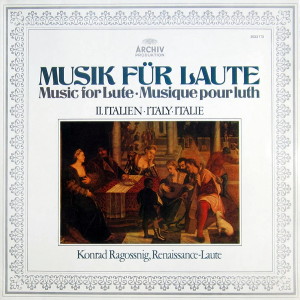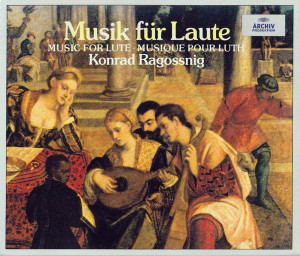 |
|
1 LP -
2533 173 - (p) 1974
|
 |
| 4 CD's -
447 727-2 - (c) 1995 |
|
| MUSIK FÜR LAUTE |
|
|
|
|
|
|
|
Lute Music of the Renaissance
- II. Italien · Italy · Italie
|
|
|
|
|
|
|
|
| Vincenzo Capirola
(1474-?) |
Ricercar I |
The Capirola
Lute Book, Ms. ca. 1517;
Newberry Library, Chicago. NA:
O. Gombosi, Publications de la
Société de Musique d'autrefois,
Neully 1955 |
|
2' 38" |
A1 |
| Vincenzo Capirola |
Ricercar XIII |
The Capirola
Lute Book, Ms. ca. 1517;
Newberry Library, Chicago. NA:
O. Gombosi, Publications de la
Société de Musique d'autrefois,
Neully 1955 |
|
3' 28" |
A2 |
| Francesco
Spinacino (ca.1470 - ca.1507) |
Ricercare |
Intavolatura di
Liuto Libro I. Venezia
(Petrucci) 1507. NA: R. Chiesa,
Antologia di musica antica Vol.
I, Milano (Suvini Zerboni) 1971 |
|
2' 50" |
A3 |
| Vincenzo Capirola |
Ricercar II |
The Capirola
Lute Book, Ms. ca. 1517;
Newberry Library, Chicago. NA:
O. Gombosi, Publications de la
Société de Musique d'autrefois,
Neully 1955 |
|
2' 39" |
A4 |
| Vincenzo Capirola |
Ricercar X |
The Capirola
Lute Book, Ms. ca. 1517;
Newberry Library, Chicago. NA:
O. Gombosi, Publications de la
Société de Musique d'autrefois,
Neully 1955 |
|
1' 00" |
A5 |
| Francesco da Milano
(1497-ca.1613) |
Fantasia |
Intavolatura di
Liuto, Venezia (Marcolini) 1536.
NA: F. da Milano, Opere
complete, ed. R. Chiesa, Vol. I,
Milano (Suvini Zerboni) 1972 |
|
2' 45" |
A6 |
| Simone
Molinaro (ca.1565 - ca.1613) |
Fantasia X |
Intavolatura di
Liuto, Venezia (Amadino) 1599.
NA: G. Gullino, Edizioni
Musicali, Firenze (Maurri) 1963 |
|
3' 45" |
A7 |
| Simone
Molinaro |
Fantasia IX |
Intavolatura di
Liuto, Venezia (Amadino) 1599.
NA: G. Gullino, Edizioni
Musicali, Firenze (Maurri) 1963 |
|
3' 12" |
A8 |
| Simone
Molinaro |
Fantasia I |
Intavolatura di
Liuto, Venezia (Amadino) 1599.
NA: G. Gullino, Edizioni
Musicali, Firenze (Maurri) 1963 |
|
1' 56" |
A9 |
| Simone
Molinaro |
Saltarello -
Ballo detto il Conte - Orlando -
Saltarello |
Intavolatura di
Liuto, Venezia (Amadino) 1599.
NA: G. Gullino, Edizioni
Musicali, Firenze (Maurri) 1963 |
|
3' 51" |
B1 |
| Giulio Cesare Barbetta
(1540-ca.1603) |
Moresca detta le
Canarie |
Intavolatura
di Liuto, Venezia
(Gardano) 1585. NA: R.
Chiesa, Antologia di
musica antica Vol. II,
Milano (Suvini Zerboni)
1971 |
|
0' 55" |
B2 |
| Giovanni Antonio Terzi
(2. H. 16. Jh.) |
Ballo tedesco e
francese - Tre parti di
gagliarde |
Intavolatura di
Liuto, Venezia (Amadino) 1593.
NA: O. Chilesotti, Lautenspieler
des 16. Jh., Leipzig (Breitkof
& Härtel) 1891 |
|
3' 54" |
B3 |
| Cesare Negri (1535-?) |
Lo spagnoletto -
Il bianco fiore |
Le gratie
d'amore, Milano (Pontio Erben
& Piccaglia) 1601. NA: K.
Scheit, Cesare Negri,
Lautentänze des 16. Jh., Wien
(Universal Edition) 1973 |
|
2' 38" |
B4 |
| Santino Garsi da Parma
(2. Hälfte 16. Jh.) |
Aria del Gran
Duca - La Cesarina -
|
Deutsche
Staatsbibliothek Berlin,
Mus. ms. 40032 u. 40153.
NA: H. Osthoff, Der
Lautenist, Santino Garsi
da Parma, Leipzig
(Breitkof & Härtel)
1926 |
|
10' 33" |
B5 |
|
La Mutia - La ne
mente oer la gola -
|
|
|
|
|
|
Gagliarda
Manfredina - Ballo del
Serenissimo Duca
|
|
|
|
|
|
di Parma -
Corenta |
|
|
|
|
|
|
|
|
Konrad RAGOSSNIG,
Laute
|
| Achtchörige
Renaissance-Laute von David J. Rubio, Duns
Tew/Oxford, 1971 (Kopie nach Martin
Hoffmann, Leipzig, 2.Hälfte des 17.
Jahrhunderts) |
|
|
|
|
Luogo
e data di registrazione |
|
Plenarsaal,
München (Germania) - 28/29 ottobre
1973 |
|
|
Registrazione:
live / studio |
|
studio |
|
|
Executive Producer |
|
Dr.
Andreas Holschneider |
|
|
Recording Producer |
|
Werner
Mayer |
|
|
Balance Engineer |
|
Klaus
Scheibe |
|
|
Prima Edizione LP |
|
ARCHIV
- 2533 173 - (1 LP - durata 46'
39") - (p) 1974 - Analogico |
|
|
Prima Edizione CD |
|
ARCHIV
- 447 727-2 - (4 CD's - durata 71'
05"; 73' 47"; 68' 14" & 62'
37" - [CD1 20-25; CD2 1-8]) - (c)
1995 - ADD
|
|
|
Cover |
|
Paolo
Veronese: Il ricco epulone
(Detail, Fresken, Venedig)
|
|
|
Note |
|
-
|
|
|
|
|
The
oldest known lute music
originated in Italy. It consists
of pieces by Francesco
Spinacino, two books of whose
were published by Ottavio
Petrucci, Venice, in 1507.
Italian lute music of the l6th
century may be divided into
three basic groups:
l. Pieces of an improvisatory
character. These are preludes
whose style is determined by the
alternation of chordal and
running passages, pieces whose
purpose is to explore the
instrument’s tonal resources and
to prepare both the player and
his listeners for the musical
performance which is to follow.
2. Contrapuntal pieces in
several voices, marked by
imitation. These pieces are
modelled stylistically on vocal
music. It was customary to “set”
for the lute, and publish as
“Intavolatura” (intabulation),
such vocal compositions as
(sacred) motets and (secular)
songs, chansons, frottole and
madrigals, imitating vocal and
contrapuntal techniques with a
view to increasing the player’s
command of the instrument.
3, Dances of all kinds.
Pieces in the first group, i.e,
far-ranging, free preludes, are
described at the beginning of
the 16th century, in the
tablatures of Spinacino and
Capirola, by the word “Ricercar”
(from ricercare = to search or
inquire). Later this expression
was extended to pieces in the
second group. As a third term
for pieces in several parts
“Fantasia” came into use from
the time of Francesco da Milano.
Like “Ricercar”, this expression
signifies that the piece in
question has been freely
invented - not an arrangement
for lute of` a vocal work
already in existence.
The majority of the dances are
in triple time, and most of
these are Galliards. Originally
conceived to follow the slow
Pavane, the Galliard became an
independent dance to an
ever-increasing extent during
the 16th century, and indeed the
most popular of dances. The
basic pattern of the Galliard
consists of five steps followed
by a leap. Illustrations show
that most figures of the
Galliard were danced in open
order, with the couples
separated. The leap can be
executed by both partners.
However, not all Galliards in
the lute tablatures were
actually intended for dancing.
Some of the compositions in
galliard rhythm are given added
interest by the insertion of
passages in imitation, and the
melodic line is broken up into
shorter notes; these pieces were
meant to be played during meals,
on excursions, and while
bathing. Their titles are often
the names of ladies, to whom
these pieces were probably
dedicated (La Cesarina, La
Mutia), but others bear
derogatory remarks such as “La
ne mente per la gola” (freely
translated: “She’s a
storyteller”).
|
|
|

